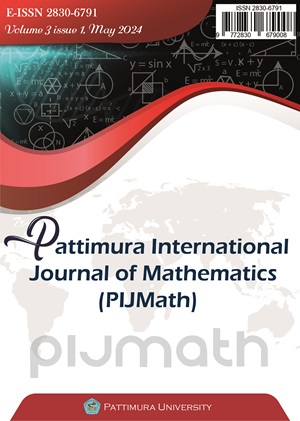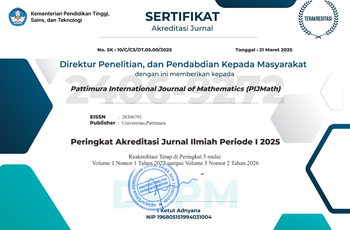A Generalization of Chio’s Condensation Method
Abstract
The Chio condensation method is a method to compute the determinant of a matrix A where by reducing the order of the matrix to a matrix. In this paper, we will generalize the condition where can be equal to zero. To compute the determinant, we can choose any element of matrix A that is not equal to zero as a pivot element.
Downloads
References
H. Anton and C. Rorres, Elementary Linear Algebra: Applications Version, 10th edition. United States : John Wiley & Sons, 2010.
H. Eves, Elementary Matrix Theory. United States of America : Dover Publications, Inc, 1966.
F. CHIÒ, M´emoire sur les Fonctions Connues Sous Le Nom De R´esultantes Ou De D´eterminans. Torino: Edité par Pons, 1853.
Rev. C. L. Dodgson, “Condensation of Determinants, being a new and brief Method for computing their arithmetical values,” Proceedings of the Royal Society of London, vol. 15, pp. 150–155, 1867.
K. Habgood and I. Arel, “A condensation-based application of Cramer’s rule for solving large-scale linear systems,” Journal of Discrete Algorithms, vol. 10, no. 1, pp. 98–109, Jan. 2012, doi: 10.1016/j.jda.2011.06.007.
A. Salihu and Q. Gjonbalaj, “New Method to Compute the Determinant of a 4x4 Matrix,” 2009. [Online]. Available: https://www.researchgate.net/publication/275580759
A. Salihu and F. Marevci, “Chio’s-like method for calculating the rectangular (non-square) determinants: Computer algorithm interpretation and comparison,” European Journal of Pure and Applied Mathematics, vol. 14, no. 2, pp. 431–450, 2021, doi: 10.29020/NYBG.EJPAM.V14I2.3920.
D. Grinberg, K. Karnik, and A. Zhang, “From Chio Pivotal Condensation to the Matrix-Tree theorem,” 2016.
Copyright (c) 2024 Any Muanalifah, Yuli Sagita, Nurwan Nurwan, Aini Fitriyah, Rosalio Artes Jr

This work is licensed under a Creative Commons Attribution-NonCommercial 4.0 International License.
The author(s) hold the copyright of the published article without restriction. This policy means that the journal allows the author(s) to hold and retain publishing rights without restrictions.
The author(s) holds the copyright of published articles without limitation. This policy means that the journal allows the author to hold and retain publishing rights without restrictions. Journal editors are given the copyright to publish articles in according to agreement signed by the author and also include statement of originality of the article


.jpg)












 This work is licensed under a
This work is licensed under a 